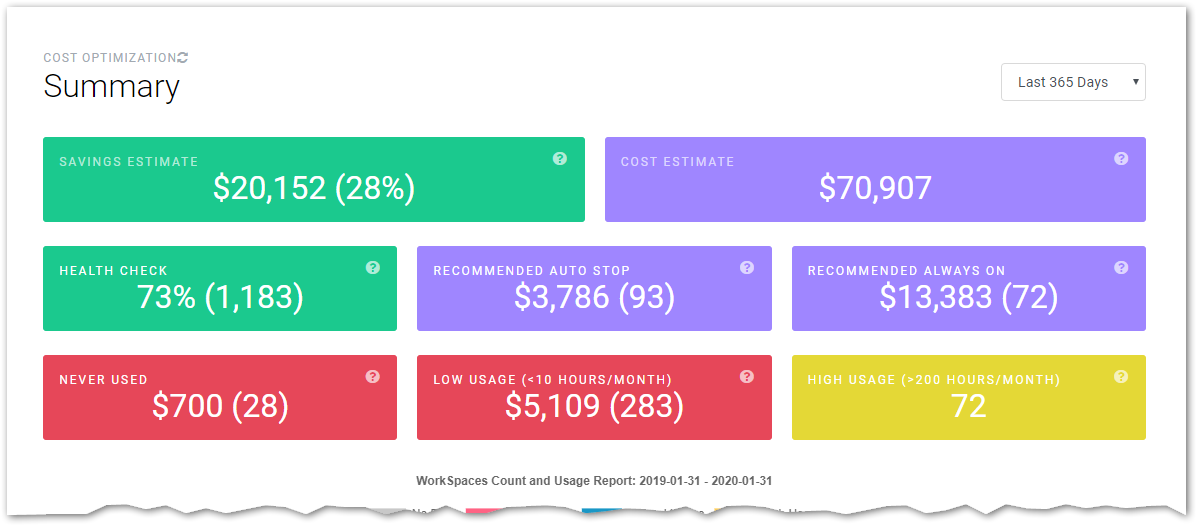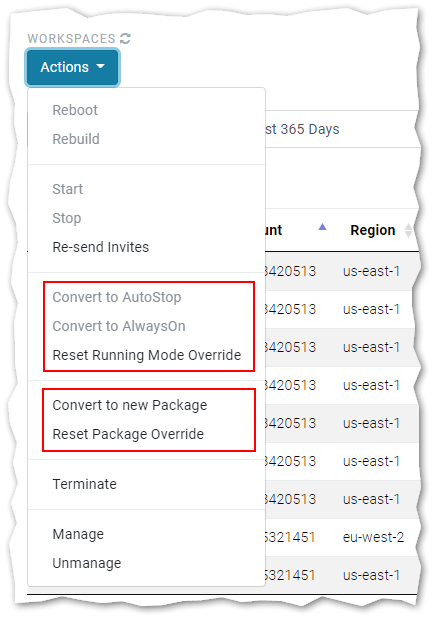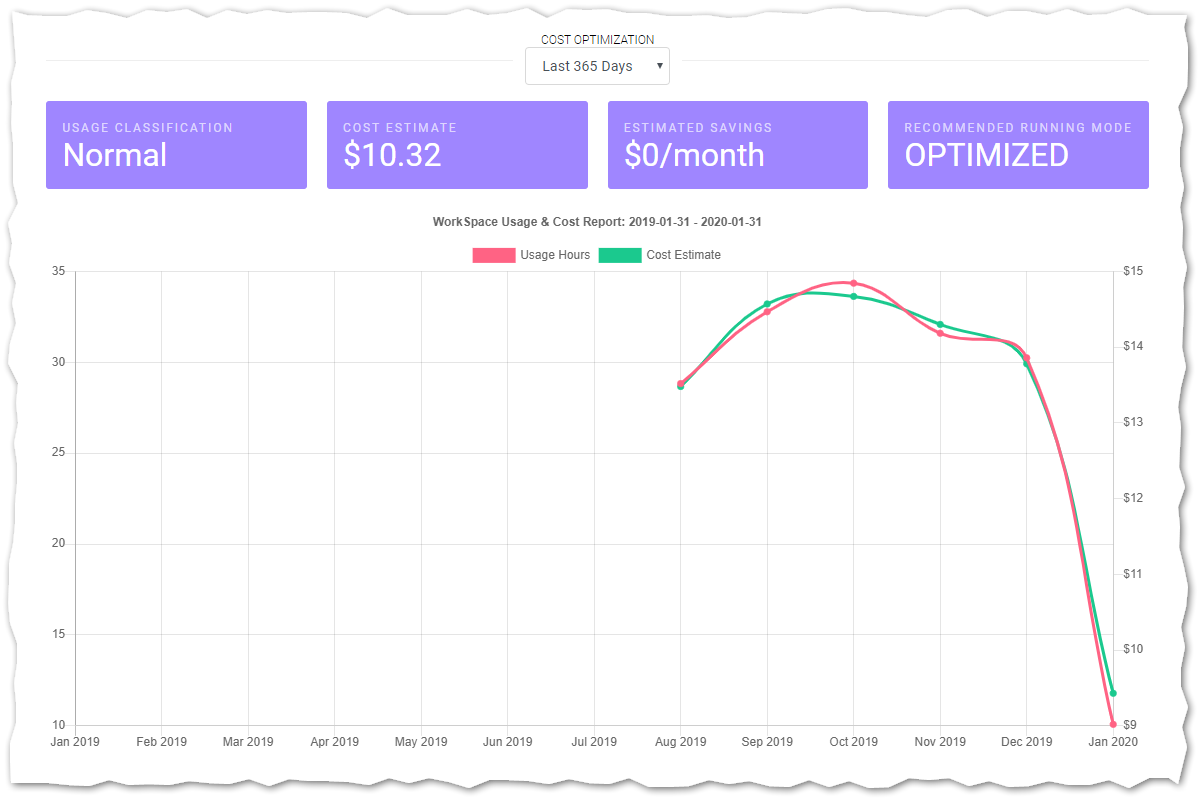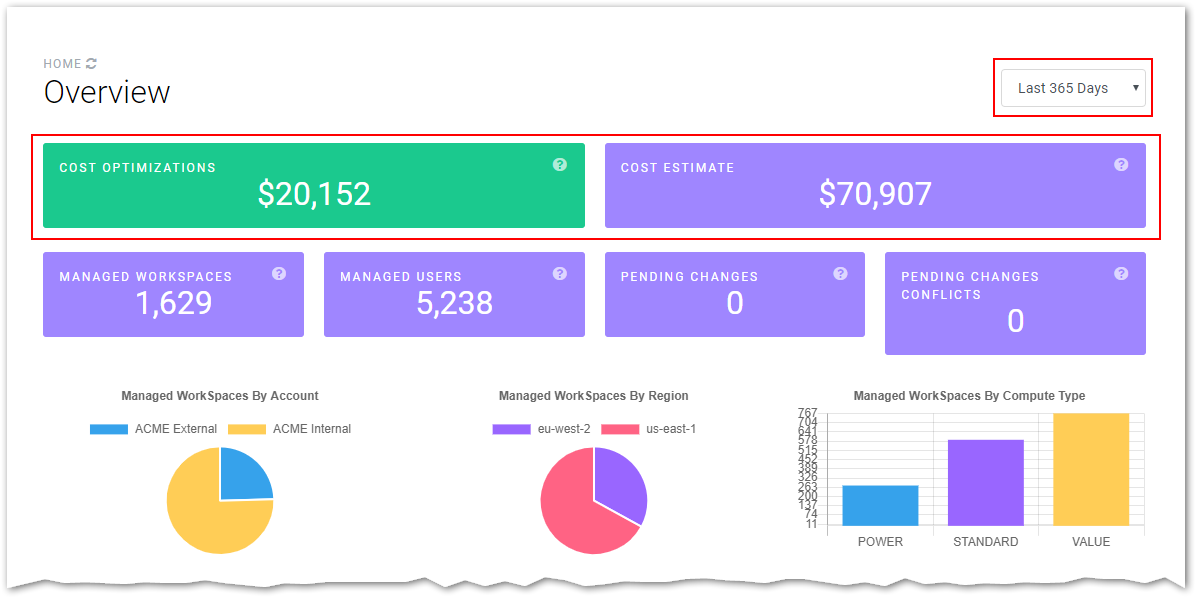Cost Optimization Guide
CLICK's cost optimization features make it simple to explore and optimize your WorkSpaces costs.
Using the cost optimization dashboard
CLICK's cost optimization dashboard contains a wealth of information to help you understand the spend and utilization of your WorkSpaces fleet, and to take action on cost optimization recommendations. The top section of the dashboard includes a number of widgets to help you understand your current spend and how to reduce it.

Date ranges, cost estimates, and recommendations
You may notice that your cost estimates change as you switch between various options in the date range dropdown that is present on many pages in the CLICK dashboard. This is because CLICK uses all of the usage data in the period you've selected to build a monthly usage pattern for each WorkSpace. For WorkSpaces set to Auto Stop (hourly billing), that usage pattern affects the monthly cost of the WorkSpace. Variations in the usage pattern over time can also result in different cost optimization recommendations.
We recommend being mindful of the date range you select, especially around times of the year when many WorkSpaces users will be idle due to vacations or other holidays.
Below is a detailed explanation of each widget.
Savings Estimate
The Savings Estimate widget reflects the total amount (in USD) that you can save each month by acting on CLICK's recommendations. It is the sum of the largest cost saving recommendations for each WorkSpace in your fleet.
Why don't the numbers match?
If you sum up the individual amounts from the detailed recommendation widgets, you may get a value that is larger than what is shown in the Savings Estimate widget. This is because some WorkSpaces are subject to multiple recommendations.
For example, if you have a WorkSpace set to Always On (monthly billing) with zero usage, cost savings will be reflected both for converting the WorkSpace to Auto Stop (hourly billing) and for terminating it because it is not being used.
In any of these cases, the Savings Estimate widget includes the largest savings identified for each WorkSpace.
Cost Estimate
The Cost Estimate widget shows the monthly cost estimate of the WorkSpaces in your fleet based on their current configuration and usage profile according to the CloudWatch metrics in your AWS Accounts.
How are cost estimates calculated?
All cost estimates in CLICK are calculated using values from Amazon Web Services' list pricing service. These prices will not reflect any special pricing or discounts your organization may receive.
Health Check
The Health Check widget calculates the percentage of WorkSpaces in your fleet that are currently in an optimized state. A WorkSpace is considered optimized if CLICK cannot identify any actionable recommendations for reducing the cost of that WorkSpace.
Recommended Auto Stop
The Recommended Auto Stop widget shows a summary of the savings you can realize by converting WorkSpaces to Auto Stop (hourly billing). This action is recommended for WorkSpaces that are currently set to Always On (monthly billing) but have a usage profile reflecting utilization below the threshold where monthly billing is the lower cost.
What is the cost threshold?
WorkSpaces configured for Always On (monthly billing) are billed at a flat rate per month.
WorkSpaces configured for Auto Stop (hourly billing) have two billing components:
- A low flat monthly rate.
- An additional per-hour charge.
The threshold is the number of hours that makes the two billing methods equal. The specific values for all of the rates vary depending on the operating system license, bundle compute type, and region in which the WorkSpace is deployed. CLICK integrates with the AWS List Pricing service to ensure all calculations use the current pricing data directly from Amazon.
Recommended Always On
The Recommended Always On widget is the inverse of the Recommended Auto Stop widget. It displays a summary of the savings you can realize by converting Auto Stop (hourly billing) WorkSpaces with high utilization to Always On (monthly billing).
Never Used
The Never Used widget displays the cost savings you can realize by terminating WorkSpaces that have not been used at all during the period you have selected with the date range dropdown in the upper right-hand corner of the dashboard. Usage data is captured from CloudWatch metrics in your AWS Accounts and reflects the amount of time the user has spent connected to their WorkSpace each day.
Treat your users right
Switching WorkSpaces between Always on and Auto Stop is a transparent change that can be made objectively without impacting the user. The decision to terminate a WorkSpace should be considered with more care. We recommend working with your users to promote adoption of the WorkSpaces platform or otherwise ensuring a WorkSpace is not needed before terminating it.
Low Usage
The Low Usage widget surfaces WorkSpaces that have less than 10 hours of usage a month. This is both an opportunity to save money by terminating unused/unneeded WorkSpaces and an opportunity to promote value by encouraging your users to do more on their WorkSpaces.
High Usage
The High Usage widget displays information about WorkSpaces that show an unusually high level of usage. Users on these WorkSpaces might be leaving the WorkSpaces Client connected even when they are not using their WorkSpace. By encouraging users to disconnect from their WorkSpaces when not in use, you will get a clearer picture of their actual usage pattern, which helps you make smarter cost optimization decisions.
In the lower section of the cost optimization dashboard, there is a chart showing your fleet's size and overall usage classifications over time.

This is a great way to monitor your cost optimization actions over time. As the low and high usage bars decrease in size, you'll gain confidence that every penny you spend on WorkSpaces is providing value to a productive user base.
Taking action on cost optimization recommendations
After reviewing the data presented by the cost optimization dashboard, you'll likely want to take action on some of the recommended changes.

Clicking on any of the widgets circled above will take you to the WorkSpaces list, pre-filtered to show the WorkSpaces related to that widget. For example, clicking on the Recommended Auto Stop widget will show you all the WorkSpaces that CLICK recommends changing to Auto Stop (hourly billing).
On the WorkSpaces list
Once on the WorkSpaces list view, you can take action by marking the checkbox next to the WorkSpaces you want to change and selecting an action from the Actions dropdown.

In the Actions dropdown, you can explicitly override the CLICK Package settings for Running Mode to switch WorkSpaces between Always On (monthly billing) and Auto Stop (hourly billing). You can also override the CLICK Package assigned to each WorkSpace for control over additional WorkSpace parameters.
Multiple layers and types of overrides
Here's a quick refresher on how CLICK's override systems work.
WorkSpace ParametersMost WorkSpace parameters are applied at two levels.
- User overrides - set on the User Detail screen.
- CLICK package - determined by membership in a CLICK-managed group.
For cost optimization purposes, the Running Mode can also be overridden at the WorkSpace level. This is performed on the WorkSpaces list or the WorkSpace detail screen and takes priority over both user overrides and the CLICK package.
CLICK PackageNormally, the CLICK package used to create a WorkSpace for a user in a particular WorkSpaces Directory is determined by the user's membership in a CLICK-managed group. The CLICK package for each Directory can be overridden on a per-user basis on the User Detail screen.
The bulk package reassignment functionality exposed on the WorkSpaces list is just another way of configuring this same type of override.

On the WorkSpaces detail screen
You can find even more detailed information on the WorkSpaces detail screen.

Here, you will see four numeric widgets and a chart.
Usage Classification
The Usage Classification widget displays the usage classification (Never Used, Low, Normal, High) for a single WorkSpace given the usage pattern in the period you have selected in the date range dropdown. This is the same usage classification as displayed in aggregate on the cost optimization dashboard.
Cost Estimate
The Cost Estimate widget shows the estimated monthly cost of this individual WorkSpace given its current configuration.
Don't forget!
If the WorkSpace is set to Auto Stop (hourly billing), the WorkSpace utilization from the entire period you have selected in the date range dropdown will be used calculate an average monthly usage profile. Because of this, if you change the value in the date range dropdown, the cost estimate may change as well.
Estimated Savings
The Estimated Savings widget shows the estimated amount you can save on this individual WorkSpace by applying CLICK's cost optimization recommendations. Note that this value may be zero if the WorkSpace is already in an optimized state.
Recommended Running Mode
The Recommended Running Mode widget displays CLICK's recommended configuration for this WorkSpace. If CLICK recommends a change, there will be an Apply button inside the widget that will apply the WorkSpace level override to change the running mode.
The usage and cost chart
Below the widgets is a chart showing the usage (red line, left vertical axis) and estimated cost (green line, right vertical axis) of this WorkSpace during the period selected in the date range dropdown. For WorkSpaces with uncertain usage patterns, this is a great way to take a more detailed look when making a cost optimization decision.
Cost estimates are based on current configuration
A WorkSpace can be switched between Always On and Auto Stop many times throughout its life. Thanks to CloudWatch Metrics, CLICK has visibility to the history of a WorkSpace's utilization pattern. But, there is no way to retrieve the history of a WorkSpace's configuration. Because of that, all cost estimates (even historical ones) are based on the WorkSpace's current configuration.
By combining the actionable insights of the cost optimization dashboard with the bulk override capabilities of the WorkSpaces list and historical perspective of the WorkSpace detail screen, you can use CLICK to surface, analyze, and act on cost optimization decisions every day of the month.
Cost optimization on the insight dashboard
The insight dashboard is mainly focused on increasing visibility into your fleet's makeup and distribution, but there are three cost-optimization related elements.

Cost Optimizations
The Cost Optimizations widget reflects the total amount (in USD) that you can save each month by acting on CLICK's recommendations. You can click this widget to go to the cost optimization dashboard and see the recommendations in more detail.
Cost Estimate
The Cost Estimate widget shows the monthly cost estimate of the WorkSpaces in your fleet based on their current configuration and usage profile according to the CloudWatch metrics in your AWS Accounts.
Date Range
In addition to controlling the history chart at the bottom of the insight dashboard, changing the date range will affect the way CLICK performs its cost estimate calculations and cost optimization recommendations.
We hope CLICK's cost optimization functionality provides you with great confidence and savings. We are always eager to hear your feedback on how we can improve.
Updated over 3 years ago
